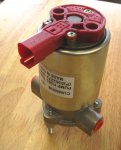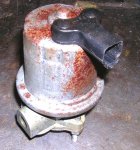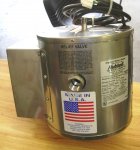EUREKA! SUCCESS!
Last fall, just before winter landed with a vengeance, The Medic Master suddenly wouldn't start. I'm smart enough to know when to call for advice/help/assistance/rescue/prayers, so I called MNtal for advice/help/assistance/rescue/prayers. With the help of Google, a Cummins manual, and some of MNtal's phone-a-friends, we determined that the odds were that the fuel lift pump on the truck's 5.9 Cummins had failed.
That's when I learned that the lift pump is the most common cause of does-not-start on a 5.9 Cummins. NAPA had a Carter lift pump for a Dodge pick up with the same engine for only $135, but winter landed, and the project got shelved until spring.
Spring finally arrived, and I decided to play it safe and buy the authentic Cummins list pump (also made in China, just like the Carter pump). With a list of more than $400, and a Freightliner "fleet" discount of 15%, I picked one up, along with a dozen spare sealing washers for the banjo fittings on the fuel lines.
Murphy's law being in total control, several sealing washers were lost, never to be seen again. Not to worry - that's why I'd bought a dozen instead of the four I actually should have needed. MNtal did the work since he fit under the truck a LOT better than I did, and I chased down tools, rags, and the rest of the required components.
And Murphy retaliated by requiring that the entire fuel system be purged and primed before he would let the truck start. Eventually, the system was filled, and the truck started. A test drive showed the vehicle to have more pep than I ever remembered it having, so the old pump may have been marginal from the day I bought the truck.
The truck is now happy, the garage floor has been washed with mineral spirits, tools have been cleaned, and life is good.
And my thanks to MNtal once again!
The new pump

The old pump

Installed

 utput with my cheater wrench. I know they suggest marking the lugs and corresponding mark on the wheel to match the torque up again ... but I bought all this stuff to swap my 22.5's for 20 super singles so it wouldn't have helped.
utput with my cheater wrench. I know they suggest marking the lugs and corresponding mark on the wheel to match the torque up again ... but I bought all this stuff to swap my 22.5's for 20 super singles so it wouldn't have helped.








